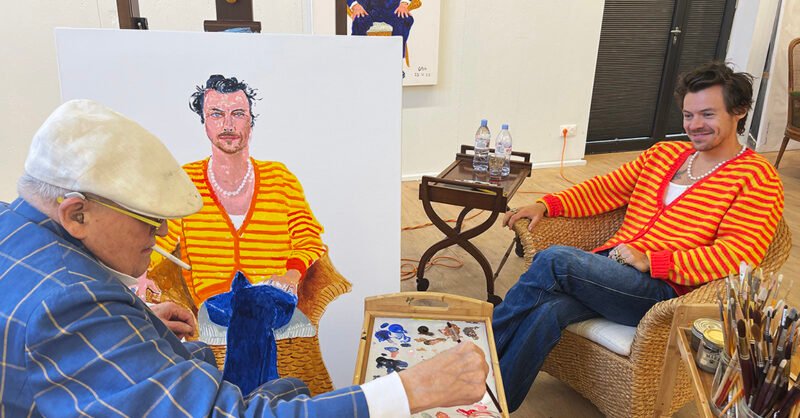
In, say, 50 years, when time has done some sifting, how will David Hockney be viewed? Will it be as the painter of the 1960s and 1970s who could capture fashionable figures in immaculate west London drawing rooms as brilliantly as light-saturated Californian swimming pools, or as the older painter entranced with the fecund Yorkshire landscape and the possibility of super-size and hyper-coloured landscape art? Maybe it will be as an early-adopter artist fascinated with the possibilities of technology, from photographic collages to fax pictures and inkjet prints to iPad drawings. Or even as an unashamedly gay artist. For some followers of his long career, however, Hockney’s most plausible claim to lasting renown will be tied to his greatest gift: his draughtsmanship.
“David Hockney: Drawing from Life”, an exhibition of his portraits at the National Portrait Gallery, ran for 20 days before Covid curtailed it in March 2020. Now it has been reprised with an extra array of portraits made in the Normandy farmhouse where Hockney sequestered himself during lockdown. It is a survey of six decades spent with a pencil in his hand, looking long and hard at the faces close to him.
The portraits centre on five sitters whom he has drawn most often over the years: his mother Laura; his close friend Celia Birtwell; his lover and amanuensis Gregory Evans; his printmaker Maurice Payne; and himself. Together, they represent innumerable hours of intimate contact, scrutiny and experimentation: a quest not just to capture what he sees but also to discover how best to preserve both the features and the personality of a human being.
Hockney, now 86, is unusual among his peers for his fidelity to drawing and to portraiture. Even when art-world fashions were fixated with abstraction and high-concept art he stuck to tradition. Indeed, there has always been a certain minimalism in his approach to portraiture. The method he settled on early was to show his subject sitting – or, depending on the relationship between them, lying – with no indication of background and minimal notice taken of clothing or furniture. He has rarely sought to contextualise his subjects but extracted them from time and place. He has unwaveringly followed this format. Style and medium vary over the years but not the essentials, which in a large show such as this one can lead to a certain plus ça change repetition.
[See also: How John le Carré infiltrated Oxford]
Individual works, however, reveal his preternatural facility. There is, for example, a room devoted to his drawings of Birtwell, the textile designer with a distinctive unruly fringe, who with her husband Ossie Clark (and their cat) was the subject of Hockney’s most celebrated painted portrait, Mr and Mrs Clark and Percy (1971). In the early 1970s he made a series of large coloured pencil drawings of her alone that capture her with extraordinary delicacy in rococo colours – pink and blue outlines and shadings that give her an ethereal presence. Elsewhere, he showed her in Picasso-pastiche – wonky-eyed and dressed in the painter’s favoured Breton shirt – and then in Matisse-pastiche, all fluid outline and rudimentary features. He has drawn her in pencil and ink, painted her in watercolour, etched and lithographed her, and included her in one of his photo collages.
This same variety is repeated in his images of Evans and Payne, hangdog and baby-chick-haired, respectively. Some of those of Evans, when he and Hockney were lovers, vary the predominant uprightness and show him sleeping among tousled sheets. Here, tenderness is added to observation, and Hockney’s pencil follows as well as describes the contours of Evans’s features.
By rights, his portraits of his mother, who died in 1999, ought to be the most intimate. They are, however, the hardest to interpret. She was not a natural sitter and rarely looks comfortable; her expression, usually avoiding her son’s gaze, tends to be wan or careworn. It is hard to discern maternal warmth or pride in her look, and hard too to sense the interplay between sitter and artist that elevates portraiture at its best. For all his ability to draw faces, Hockney can often be strangely immune to facial nuance. He is here the master of blank expressions.
It is with the most recent paintings that a real pathos enters the exhibition. These works, some 30 of them, show visitors to his Normandy demesne in 2022. “A portrait should be done quickly. To do a portrait slowly is a bit of a contradiction, really,” said Hockney in an interview last year – himself contradicting so many of the pictures in this exhibition – and these recent portraits are immediate, large, bright, often jolly and executed directly in acrylic paint without underdrawing or preparatory studies.
Unfortunately, they also reveal the diminution of his skills. The sureness of line and indivisibility of hand and eye that so distinguishes his earlier work has turned to wavering, and finesse to clumsiness. The ability to capture a likeness has faded too, as evidenced most painfully by his portrait of pop man-boy Harry Styles, who would be unrecognisable if not for his stripey cardy and pearl necklace. These portraits may be evidence of Hockney’s dauntlessness and urge to create but many are avert-your-eyes works, inescapably an old man’s paintings.
If the young Hockney’s portraits show a remarkable maturity, the elderly artist’s show a poignant regression. All the same, the exhibition is an absorbing showcase for Hockney’s remarkable skill, but the pre-Covid version was kinder.
“David Hockney: Drawing from Life” at the National Portrait Gallery runs until 21 January 2024.
[See also: The fatal flaw in the “final” Beatles song]
Content from our partners
This article appears in the 08 Nov 2023 issue of the New Statesman, The Age of Fury






